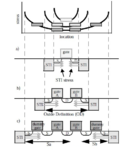VLSI Bravo
Junior Member level 3

Hi all,
can any one explain why nmos current will decrease and Pmos current will increase in shallow trench isolation. pls explain STI effect in detail.
thanks in advance.
can any one explain why nmos current will decrease and Pmos current will increase in shallow trench isolation. pls explain STI effect in detail.
thanks in advance.





